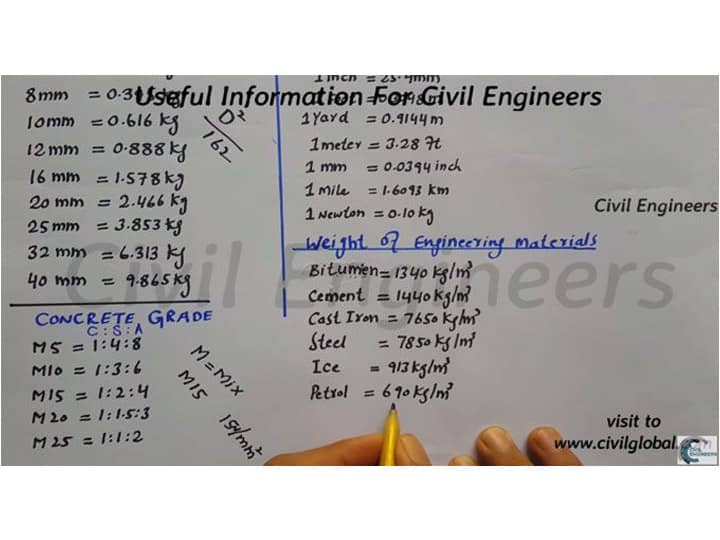If you are a civil engineer, you have to make may calculations in your head a lot, from every once in a while. Almost all of those will be related to the construction methodologies. Therefore, you need to remember quite a bunch of important civil engineering formulas and metrics. Today, we will list many such common construction formulas and information here.
The information and formulas here contain specifics that will help you to figure out essential details about steel bar weight per meter or total, construction materials quantity and weight, unit conversion criterion and factors, concrete grade ratios, and much more!
| Bar Diameter | Weight in kgs |
| 6 | 0.222 |
| 8 | 0.395 |
| 10 | 0.616 |
| 12 | 0.888 |
| 16 | 1.578 |
| 20 | 2.466 |
| 25 | 3.853 |
| 32 | 6.313 |
| 40 | 9.865 |
| 1 Unit | Converting to | Value |
| Inch | Millimeter | 25.4 |
| Foot | Meter | 0.3048 |
| Yard | Meter | 0.9144 |
| Meter | Foot | 3.28 |
| Millimeter | Inch | 0.0394 |
| Mile | Kilometer | 1.6093 |
| Newton | Kilogram | 0.10 |
| Material | Weight per volume (kg/m3) |
| Bitumen | 1340 |
| Cement | 1440 |
| Cast Iron | 7650 |
| Steel | 7850 |
| Ice | 913 |
| Petrol | 690 |
Concrete is graded according to its compressive strength or force. The grade is indicated by a number after the letter 'M'. The bigger the grade number, the stronger the concrete. For example, M5 < M10 < M30 etc.
The 'M' means 'Mix', and the number denotes the numerical figure of the compressive strength of that type of concrete (at 28 days). So, when someone says they have used M10 grade concrete, it means they have used a type of concrete mix that would be able to hold up to 100 grams of force applied per square millimeters of that concrete after at least 28 days of settling.
Following are the ratio specifics of common concrete grades:
| Concrete grade | Compressive strength | Mix ratio (cement: sand: aggregate) |
| M5 | 5N/mm2 | 1 :4 :8 |
| M10 | 10N/mm2 | 1 :3 :6 |
| M15 | 15N/mm2 | 1 :2 :4 |
| M20 | 20N/mm2 | 1 :1.5 :3 |
| M25 | 25N/mm2 | 1 :1 :2 |
We hope the above information was useful to you. Please let us know your thoughts and suggestions using the contact portion below. Till next article, happy building!
